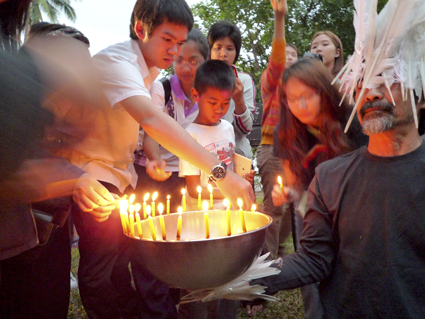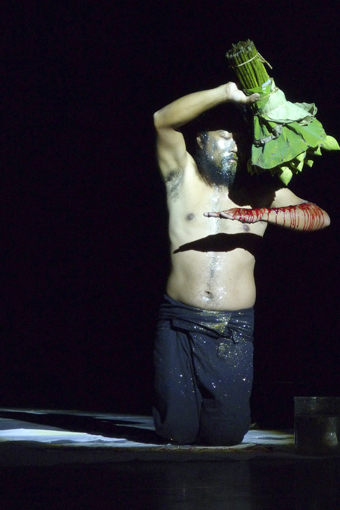eartheffect: glitter and blood
yiorgos zafiriou: asiatopia 13, international performance art

Chumpon Apisuk, Asiatopia 13
photo Yiorgos Zafiriou
Chumpon Apisuk, Asiatopia 13
AT DUSK, A CROWD GATHERS AROUND CHUMPON APISUK IN AN OPEN GRASSY AREA. HE HAS THE AUDIENCE PLACE LIT CANDLES ON THE RIM OF A LARGE STAINLESS STEEL BOWL. HE WRAPS HIS FOREHEAD AND HANDS IN A LONG BAND OF WHITE FEATHERS AND LEADS THE CROWD THROUGH THE PARK, BALANCING THE FIERY BOWL ON HIS FEATHERED RIGHT HAND.
This was a perfect way to lead a procession; a physical act of ritual where movement and transformation are key. Later when I ask about the symbolism of the feathers, he explains that some caged ducks, unable to escape, perished in the Bangkok floods. It heightened the meanings of flight and freedom I ascribed to the work. Apisuk is a leading international figure in performance art. His vision to bring it to Thailand created the impetus for the Asiatopia Festival, now in its 13th year and managed by the efforts of Concrete House Artists’ Collective. Asiatopia is a global event and has established itself as an important space for exchange amongst local and international artists.
Asiatopia 13 was a creative feast, realising the unpredictability often attached to performance art. There were strange happenings and subtle movement, there was blood and glitter and fire and it got very messy. Presented as an International Performance Art Festival, Asiatopia 13 was underpinned by its title Eartheffect [sic] giving artists space to explore and expose schisms on the earth, in the self, humanity, faith, politics, life and love.
Eartheffect was driven by serious events that shook the planet in 2011 in Japan, New Zealand, Chile and Haiti after which lives became irrevocably transformed. This solemn backdrop kept the fragility of life ever present throughout Asiatopia 13 with artists investing a genuine care and mindfulness in their works while still unpacking the complexities of personal and political upheavals.
Asiatopia 13 ran over three consecutive weekends during the flooding in greater Bangkok requiring the first weekend’s performances to be relocated from Bangkok’s Art and Culture Centre to the Fine Arts Department of Chiang Mai University. The following weekend was held in Suan Buak Haad Park (Chiang Mai) and the final performance, Artists’ Party, was a splinter event held on the rooftop auditorium of the Klang Plaza Shopping Mall in Nankorn Ratchassima (Korat City).
Communicating ideas and emotions through performance can be complicated. Asiatopia 13 was saturated with a breadth of imagery, abstract, ephemeral and personal in nature—sometimes exhausting to take in. I viewed the work through the prism and problematics of critique. For the artists, I imagine their critiques are of ideas, the self, the law and bureaucracy. In some cultures it is difficult or impossible to question authority let alone one’s own autonomy. However, performance allows a retreat into the poetics of a symbolic language which transcends both words and borders. This can reveal an artist’s inner anxieties communicated as performance, albeit in only one direction, from the artist to the audience. The artist can also seek to unravel their own performance language.
Nopawan Sirivejkul throws marbles at the start of her piece signifying that she’s playing with her life. She’s surprised when I later explain that in English “losing your marbles” is akin to becoming mentally unhinged. This highlighted the idea of performance as culturally coded and always at risk of being lost in translation.
Suan Buak Haad Park was brimming with a vibrant life of its own, people enjoying Chiang Mai’s temperate climate: running, walking dogs and doing other parky things. Having the festival in a park made it a public event capturing a diverse audience who at times were unaware of what was actually happening, though the artists and the details of the event were announced in Thai and English. The public were truly engaged by the works presented in a country where, as elsewhere, sound financial support is scarce for performance art while traditional art forms are favoured. Artists in Asiatopia 13 largely self-funded their participation with some having additional support from their respective countries.

Boonsong Rodthab, Asiatopia 13
photo Yiorgos Zafiriou
Boonsong Rodthab, Asiatopia 13
It was inspiring to see the involvement of younger artists. Sitthikan O Techadilok handed out ceramic animals to the audience, especially to children who constituted a significant part of the audience in the park. He then sat cross-legged and after some playful gestures with his menagerie on a small checked tablecloth, he folded the animals into the cloth and reached for an enormous metal wrench. The result was carnage, one brutal act echoing the human relationship with nature: interventionist, controlling and sometimes ultimately destructive.
It’s a rare occasion when performance ceases to be a cerebral experience for me, becoming something far more elusive. Boonsong Rodthab’s performance had me gasp in awestruck fascination. In the cavernous space of the top floor of a shopping mall, a handful of glitter is abruptly sprayed onto the artist’s face and a beautifully clustered bunch of lotus buds, when overturned, literally bleed onto his hands, arms, over his body and then onto a white cloth. The work was serious and serene. It was Oriental and Occidental; it’s blood that binds us all.
Perpetua Rodriguez actions a more intimate work. She strips bare and circles herself with earth. Then using a 10m rope she connects herself to a randomly selected member of the audience, leading him on a path through the dimly lit auditorium to a space under the stage with the rope firmly tied around his waist. There was an elusive type of vulnerability in the slow walk through the space with her nakedness in marked contrast to the clothed stranger and the audience following in slow procession. The piece pivots on an historicising of performance art, referencing Rope Piece (1983/84) by Linda Montano and Tehching Hsieh in which the two were tied together for one year. Rodriguez’s piece acted as a reminder of the important role Asian artists have played in developing performance art.
Asiatopia firmly places itself as a centre for performance art and demonstrates a maturity that extends beyond any seemingly fleeting fascination with the form found in the region through the 90s.
Asiatopia 13 was a phenomenally interesting experience, at times exhausting to watch and a challenge to unravel meanings in the works of so many artists. It was bold and brazen, expressing a fresh freedom for artists to explore performance art. As writer and critic Thomas Berghuis has proposed, performance art is an unsung yet critically developed medium in the Asia Pacific.
Asiatopia 13, Bangkok and Chiang Mai, Thailand, Nov 23-Dec 11, 2011
RealTime issue #107 Feb-March 2012 pg. 14






